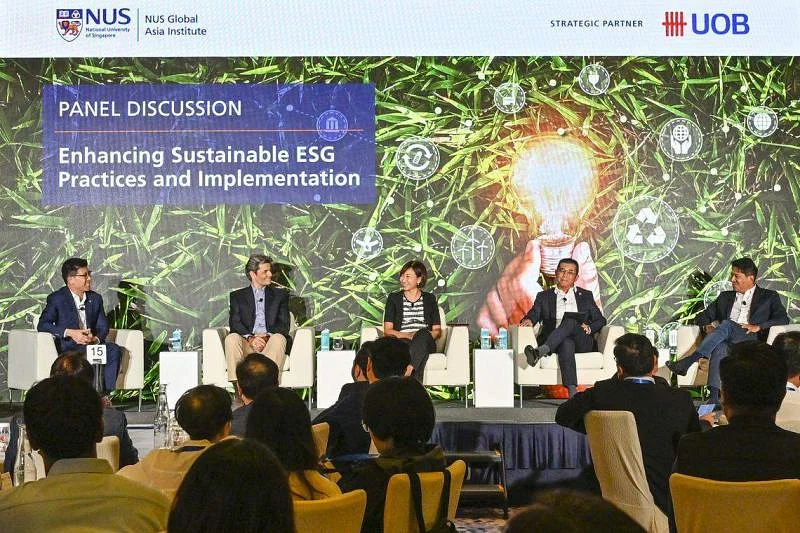ECONOMIES have slowed down sharply. Long dormant inflation has erupted. Central banks have switched abruptly from long-term quantitative easing to rapid quantitative tightening, with recent rate hikes triggering the sudden failure of several banks.
Indeed, with these snatching headlines, the environment for business has “dramatically altered” as the world returns to a post-Covid, new normal, said Frederick Chin, UOB’s head of group wholesale banking and markets.
Speaking in a keynote address at the 12th Wee Cho Yaw Business Forum on Mar 17, he identified three key opportunities for Asean. The one he delved a little more deeply into, however, was Asean’s advantage in a re-globalised world.
He said the decoupling of US and China since the 2018 trade war might have dampened the globalisation momentum, but major economies remain highly interconnected, thriving on trade and collaboration.
Today’s multipolar world, he continued, should thus be expecting a new post-Covid era of re-globalisation alongside a different set of geopolitical objectives, which would lead to new investment opportunities for Asean.
This is because Asean remains competitive – in terms of its cost, young labour force, and infrastructures – to take advantage of reorganised supply chains, he said.
With that, he believes that Singapore’s total trade flows will exceed its current estimated valuation of about US$1 trillion annually. “I expect that number to grow larger as Asean is poised to return as the production base to the West and China,” he said.
The US$1 trillion figure, he noted, was calculated based on Singapore’s 40 per cent stake in Asean trade, owing to its status as a transshipment hub and financial centre.
Zooming in on the Asean trade pie, estimated to be closer to US$2.5 trillion, Chin said just under US$900 billion relates to the region’s trades with China, while over half a trillion US dollars relates to its trades with the US.
Intra-Asean trade accounts for another US$600 billion to US$650 billion, while Asean trades with Europe make up the last remaining chunk.
The forum that Chin spoke at was organised by the National University of Singapore’s (NUS) Global Asia Institute, with UOB as the strategic partner.
The annual event, which was established in 2008 with a donation from then-UOB chairman Wee Cho Yaw and his family to bring together academic and industry experts to share thought leadership, returned this year after taking a three-year pause due to the pandemic.
Before an audience of more than 240 business leaders, Chin also spoke about the enduring place of technology and innovation, and opportunities in global climate action.
While noting that cheap capital is of the past and high valuations are destroyed in the tech sector, he said that “more opportunities will arise as companies transform their organisation and operations”.
“Technology and innovation will continue to shape and reshape our lives and remain a core investment theme for all sectors,” he added. Nevertheless, he noted monopoly, ethics and cyber risks as external negativities to watch in the sector.
Within climate action, he pointed out that the 2050 transition capital requirement is more than US$120 trillion, of which 50 per cent will be in Asia.
“This provides new opportunities as companies decarbonise their operations, and transition towards net zero targets,” he said. “To seize the opportunity presented for businesses within Asean, we must be prepared.”
Besides, environmental, social and governance (ESG) issues are becoming mainstream and last November’s United Nations Convention on Climate Change emphasised implementation, he added.
Implementation happened to be the topic of the panel discussion that followed, in which Japfa chief financial officer Kevin Monteiro shared how he used a “whole of company” approach to get sustainability buy-in at the mainboard-listed agri-food company.
Initially, the company too faced “a lot of resistance”, with those in charge of operations wondering why the company would choose to impose an additional cost on chicken, an inexpensive protein, when competitors are not doing it.
That helped Japfa realise that it was not enough for top management to be trained on this, said Monteiro, it was also important to embed sustainability thinking within the whole organisation to achieve sustainability impact.
That was why the group moved to extend sustainability training to financial controllers – who tend to be the “driver” or “blocker” of sustainability initiatives, depending on where they stand, he said – and will now make sustainability a training priority across all functions.
Nevertheless, what helped with acceptance was the company’s ability to raise financing at a lower cost, he said: “That’s a real tangible benefit that people could see and take home.”
Incentives should be given to banks to hand out more “carrots” for companies to help embed sustainability within their organisations, he suggested. “Policies or incentives via banks would be a real touch point moving forward,” he said.
At another panel discussion on supply chain resilience, NUS’ Goh Puay Guan pointed out that the pendulum to supply chain approaches is still swinging as companies work on balancing cost and resilience needs.
To deal with disruptions such as shipping delays, companies have had to shift from a cost optimal “just in time” approach to the more costly “just in case” approach, featuring supply chain diversification and larger inventories.
But when things return to normal, the question that comes up is “when will the chief financial officer win”, quipped the associate professor in supply chain management and technology management.
“To some extent, companies have to diversify,” he said. “But what is the extent by which you find balance of diversification versus cost optimisation? (This is something to watch) in the next two years.”
Source: The Business Times. Link Here.
March 29, 2023













